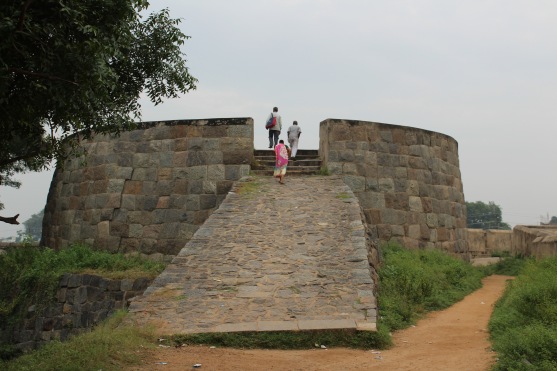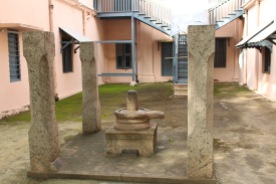The summer sun bore down up on the pains of Vellore. Dust clouds rose to the commands of the fickle breeze. Grass and shrubs shriveled in the heat. The Fortress of Vellore gleamed like a pearl in the barren plain. The sunlight reflected from the moat gave sparkling silver outline. A stray goat wandered about and decided to quench its thirst in the murky waters of the moat. An arrow shot from the rampart put an end to its hydrophilic dreams. Mutton was on the day’s menu.
There was silent but constant buzz around the fort. Whispers were passed about. The soldiers looked at their new uniforms with disgust. Leather tops and round hats. To wear clothes made of cow hide. Inconceivable!
The soldiers thought the new uniforms and laws were made to insult them and their religion. They complained about the uniforms and refused to shave their beards, but their protests fell on deaf ears. Every soldier with a beard and without an uniform was tied to a post and given 90 lashes.
This new law was the final snowflake on the mountain top. It fell on the suppressed anger of the sepoys. Something rumbled and gave way. It was an avalanche of rage. The sepoys decided to sink their teeth in the heels of the East India company.
After Tipu Sultan had died. His sons and daughters were brought from Srirangapatanam and imprisoned in the garrisoned Fortress of Vellore. The wedding of Tipu Sultan’s daughter, in 1806, gave the soldiers a perfect excuse to get together and plan the mutiny.
On the night of the wedding, under the cover of chaos and celebration, the cry of revolution rose from the ramparts of the fort. A bonfire was lit from the highest tower of the Fort. A signal for the mutineers. It was a bonfire of the new uniforms. The 1500 strong garrison rebelled against their British overlords.
Fire and gunpowder rained upon the British officers, drunk on the festivities of the wedding. The fireworks in the sky were overshadowed by the gunshots on the ground. Blood stained fort walls. More than a hundred British soldiers were killed in mutiny. Col. John Fancourt, the British commander of the Vellore Fort was also killed. In the chaos, Major Coopes one of the British officers, slipped away. He jumped into the moat, swam across and escaped to the British garrison at Arcot.
Unaware of this, the sepoys were celebrating their victory. The Union Jack was lowered and the Tiger-standard of Mysore was hoisted. Sehezada Fateh Hyder, the son of Tipu Sultan was crowned king of Vellore. Wine flowed freely. Cheers and Chants made round. .
Major Coopes in the meantime trekked 25 km overnight and reached Arcot. He informed COl. Gillespie, the commander of the Arcot Garrison of the fall of Vellore. Once informed of the mutiny, the British cavalry at Arcot rode forth swiftly to Vellore. They covered the 25 km distance in two hours. They blew apart the gate of the fort with canons and unleashed Hades on the celebrating sepoys. Within a couple of hours, all the mutineers were either dead or in chains. Canons and firing squads sounded the entire day. Retribution was swift and certain. The Fortress of Vellore was back in the hands of the East India Company.
Thus ended the first ever Indian mutiny against the East India Company.
—————————————————————————————————————-

The hot and barren town of Vellore is still dominated by the Fort and its serene moat. The wide ramparts and the tall walls provide a daunting obstacle to any attacker. The fort was used by the British to imprison Tipu Sultan’s sons and daughters.
The Sepoy Mutiny at Vellore was a prelude to the greater and more famous Revolt of 1857. The controversial dress codes were revoked after the mutiny.
Some interesting reads:
- First hand account of Lady Amelia Fancourt – the wife of Col. John Fancourt, the commander of the Vellore Fort who was killed by the mutineers: An Account Of the Mutiny at Vellore, by the Lady of Sir John Fancourt, the Commandant, who was killed there July 9th, 1806. (upenn.edu)
- The poem ‘Gillespie’ by Sir. Henry Norton, depicts the muster of the cavalry of Arcot and the recapture of Vellore: http://www.poemhunter.com/best-poems/sir-henry-newbolt/gillespie/















